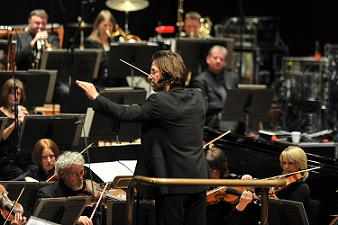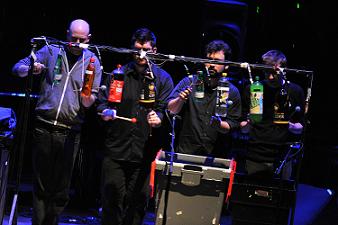Sometimes you can leave a concert feeling slightly shortchanged: a perceived weakness in the programming; an unprepared, lacklustre conductor; a phoned-in performance. No danger of any of the above at the marathon session three of Reverberations, a weekend of concerts at LSO St Luke's and the Barbican devoted to the music and influence of the contemporary US composer Steve Reich. Actually, by the end of the evening, some people may have been ruing just how many artists have fallen under Reich's influence. We filed into the Barbican at 6pm on Saturday. We left the hall at 12.15am on Sunday morning with Reich's 2x5 ringing in our ears. Breaks notwithstanding, the diehards who stayed to the bitter end ought to have been given a medal on the way out.
In total, we heard 13 works in a little over six hours, including the European premiere of Reich's new string quartet, WTC 9/11. Coming just a day after the coroner's report into the 7/7 attacks on London, the timing was especially poignant.
We were eased into the third of six sessions with Reich's most benignly contemplative work, Variations for Winds, Strings and Keyboards. Featuring endlessly sustained string lines superimposed against faster melodic patterns in keyboards, flutes and oboes (a changeless v ever-changing layering that Reich discovered in the music of the 12th-century French composer Perotin), the BBC Symphony Orchestra under guest conductor André de Ridder (pictured below right, photo Mark Allan) captured the work's beatific detachment to perfection. And the sumptuous, harmony-enriching brass chords that slowly drift into your consciousness in the two outer variations were beautifully balanced.
 If Variations was programmed first to lull us into a false sense of security before Anna Clyne's more obvious curtain-raiser, Rewind, it certainly worked. Inspired, as its title suggests, by the image of analogue video tape rapidly scrolling backwards, I was hugely taken with this orchestral firework. The London-born Clyne, currently Mead Composer in Residence with the Chicago Symphony Orchestra, infuses the work with the tropes of modern dance, specifically the choreography of Kitty McNamee (artistic director of the Los Angeles-based Hysterica Dance Company). The work's breathless, edge-of-the-seat quality and its final conceit - a literal rewind of the music itself, pre-recorded and triggered by a laptop - suggests a composer with a singular imagination. Clyne has posted the work on the Soundcloud website, so you can listen and judge for yourself.
If Variations was programmed first to lull us into a false sense of security before Anna Clyne's more obvious curtain-raiser, Rewind, it certainly worked. Inspired, as its title suggests, by the image of analogue video tape rapidly scrolling backwards, I was hugely taken with this orchestral firework. The London-born Clyne, currently Mead Composer in Residence with the Chicago Symphony Orchestra, infuses the work with the tropes of modern dance, specifically the choreography of Kitty McNamee (artistic director of the Los Angeles-based Hysterica Dance Company). The work's breathless, edge-of-the-seat quality and its final conceit - a literal rewind of the music itself, pre-recorded and triggered by a laptop - suggests a composer with a singular imagination. Clyne has posted the work on the Soundcloud website, so you can listen and judge for yourself.
While you could admire the premise of Michael Gordon's Rewriting Beethoven's Seventh Symphony, receiving its UK premiere here, it was a difficult work to love. The Bang on a Can co-founder borrows a central musical idea from each movement of the host work – including the imposing opening chords of the first movement – and runs with the material, but to my ears it felt slightly too in thrall to the original to really take flight.
The freestage event presented one of the evening's real surprises. Composed by another Bang on a Can co-founder, Julia Wolfe's LAD for solo bagpipes used drones and massively drawn-out glissandos to build up a sound scape of quite mind-numbing intensity. I have no idea if there's a collective noun for pipers (a phalanx, perhaps?), but through a looping process soloist Donald Lindsay seamlessly constructed multiple lines that built to a climax of such shocking and strident proportions that several people had to vacate the area, if not the premises. Note to London Underground: stop pussyfooting around with Mozart and Beethoven and get LAD on the sound system. It will have people running for the exit (and I mean that as a compliment). The big tune, when it finally arrived, came as a total surprise.
With our ear canals thoroughly cleansed, the Tyondai Braxton pieces from Central Market provided a riot of instrumental, vocal and electronic colour, with the crunching bitonality and ostinatos of Stravinsky's Petrushka seemingly a key reference point. Featuring vocal quintet (doubling on kazoos, and very nifty too), guitars, strings and some especially heroic work by the BBC Symphony's co-principal percussionist, Alex Neal, Braxton - best known as former frontman of the avant-rock quartet, Battles – must have bunkered down in the studio for weeks to create this assault on the senses. Not to be outdone by Wolfe, a particularly monolithic synth drone threatened at one point to loosen some of the Barbican's light fittings.
 Another break, another stage reconfiguration, and then it was the turn of long-standing Reich collaborators the Kronos Quartet (pictured left, photo Mark Allan). One of their many commissions, Aheym (Homeward) by the NYC-based composer, guitarist (with rock band The National) and curator Bryce Dessner, was a musical evocation of the idea of flight and passage and a tribute to his grandmother (Dessner's paternal family were Jewish immigrants from Poland and Russia). The quartet's shaping of Dessner's vibrant counterpoint was thrillingly sustained. Following an arrangement of the traditional Jewish memorial prayer, Ov Horachamim, an extract from Perotin's towering Viderunt omnes and selections from Reich's video opera, The Cave, it was time for WTC 9/11.
Another break, another stage reconfiguration, and then it was the turn of long-standing Reich collaborators the Kronos Quartet (pictured left, photo Mark Allan). One of their many commissions, Aheym (Homeward) by the NYC-based composer, guitarist (with rock band The National) and curator Bryce Dessner, was a musical evocation of the idea of flight and passage and a tribute to his grandmother (Dessner's paternal family were Jewish immigrants from Poland and Russia). The quartet's shaping of Dessner's vibrant counterpoint was thrillingly sustained. Following an arrangement of the traditional Jewish memorial prayer, Ov Horachamim, an extract from Perotin's towering Viderunt omnes and selections from Reich's video opera, The Cave, it was time for WTC 9/11.
Making a haunting counterpart to Different Trains, another work commissioned by Kronos, WTC 9/11 similarly uses pre-recorded voices in all three of its movements. These include US air traffic controllers, concerned that American Airlines Flight 11 (the first plane to crash into the World Trade Centre) was off course, the NYC Fire Department, interviews with friends and neighbours of Reich who lived or worked in Lower Manhattan, plus two volunteers who took shifts to sit near the bodies as they awaited burial, reciting psalms and other biblical passages (a Jewish custom known as Shmira).
As with Different Trains, certain phrases stick in your mind and replay themselves (they're still bombinating around my head as I write): "No contact – no contact with the pilot – no contact with the pilot whatsoever"; "I knew it wasn't an accident right away"; "What's gonna happen here next?" You hear a total of three quartets, one live and two pre-recorded, with the strings subtly doubling and harmonising the speech melodies of the recorded voices. The manner in which Reich elongates the speaker's final vowels or consonants, as a way of connecting one speaker to the next, produces a kind of ghostly resonance to the spoken element which adds immeasurably to the overall effect.
In its gradual movement from one percussion group to another (suspended plastic bottles, tuned drums, vibraphones/xylophones), its build-up of complex interlocking patterns, not to mention the visceral excitement of a bunch of blokes hitting drums really, really hard, the collaboration between Baltimore's "electronic iconoclast" Dan Deacon and So Percussion (pictured below right, photo Mark Allan) – the enigmatically titled Ghostbuster Cook: The Origin of the Riddler – clearly had Reich's Drumming as its model.
 The honour of bringing this sprawling Reichathon to a conclusion fell to Bang on a Can All-Stars, heard first with Sonic Youth guitarist Lee Ranaldo in How Deep Are Rivers?, a searing in memoriam to Ranaldo's friend Epic Soundtracks.
The honour of bringing this sprawling Reichathon to a conclusion fell to Bang on a Can All-Stars, heard first with Sonic Youth guitarist Lee Ranaldo in How Deep Are Rivers?, a searing in memoriam to Ranaldo's friend Epic Soundtracks.
The final work, 2x5, offered something entirely new within Reich's oeuvre, namely its stylised rock-group instrumentation of two electric guitars, electric bass, piano and drums. On the Nonesuch recording of the work, Bang on a Can used pre-recorded tracks for the additional quintet. This London premiere featured all 10 instruments live and, if it was not quite as polished as the recording (there was a slight rhythmic hiccup in the pianos in the opening movement), it possessed enormous heft and groove. It made the recording sound polite by comparison. With the electric basses and pianos providing the motoric backdrop against which the tintinnabulating, laissez-vibrez guitar lines chimed, 2x5 illustrated how Reich's capacity for writing eloquent, exhilarating and ear-catching music remains undimmed. The composer, in his trademark baseball cap, took to the stage to thunderous applause.














Add comment